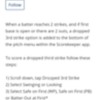from MLB.com
A catcher is given a passed ball if he cannot hold onto a pitch that -- in the official scorer's judgment -- he should have, and as a result at least one runner moves up on the bases. Passed balls have commonality with wild pitches, as both allow a runner to advance on his own without a stolen base. However, there is a key difference: A passed ball is deemed to be the catcher's fault, while a wild pitch is deemed to be the fault of the pitcher.
A passed ball is not recorded as an error, but when a run scores as the result of a passed ball, it does not count as an earned run against a pitcher. (In cases where this is in question, the official scorer must reconstruct the inning, and if the run would not have scored without the passed ball, that run is deemed unearned.) If a runner advances on a passed ball, he is not credited with a stolen base.
After a strikeout, if the catcher fails to catch the third strike, and the batter reaches first base safely as a result, either a passed ball or a wild pitch must be awarded. In the instance of a wild pitch, that baserunner could count against a pitcher's ERA, but in the instance of a passed ball, he cannot.
The rule says the wording caught with ordinary effort as determined by scorekeeper. Anyone who says that scorekeeping is not judgement calls is wrong. Someone has to determine ordinary effort. If the ball is a good curve ball that drops off the table and hits the ground behind home plate before the catcher it should have been caught. The catcher knew what pitch was coming and should catch it so it is a passed ball. If you are a third baseman in D1 baseball, you know you are playing the hot corner so you should catch shots hit at you at 100 mph EV. I still hold that it comes down to the judgement of the scorekeeper even in MLB or college. I get amazed at how many times in P5 SEC baseball they say it was a hit because that was a shot. If it hits the glove with ordinary effort and the fielder misses it then it is an error, no matter the speed of the ball.




